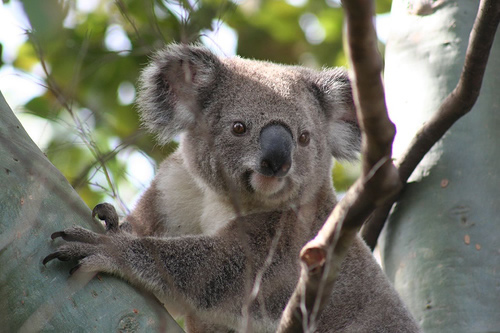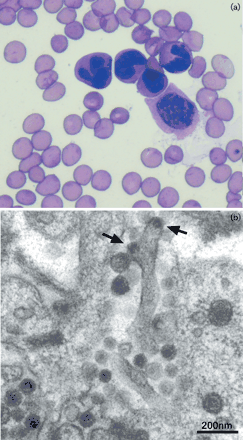Koala Retrovirus
A Viral Biorealm page on the family Koala Retrovirus

Koala Retrovirus, otherwise known as Koala Immunodeficiency Virus (KoRV), is a retrovirus that infects Koalas (Phascolarctos cinereus), especially in populations located in mainland Australia. Koala retrovirus is believed to be a primarily endogenous virus present in a large proportion of Australian koala populations. Studies have suggested that the virus is responsible for the very high incidence of chlamydosis, leukemia, and lymphoma seen in koalas [1]. The primary method of viral proliferation is vertical transfer via an endogenous form of the virus, while evidence exists that the virus is transmitted horizontally only through close contact between individuals [2].
Virus Classification and Higher Order Categories
The koala immunodeficiency virus is a retrovirus falling into the group VI division of the Baltimore Classification system. Koala retrovirus virions contain positive-sense single stranded RNA, and have a DNA intermediate in their replication cycle (+ ssRNA-RT). Koala retrovirus belongs to the family Retroviridae, and the genus Gammaretrovirus. Particular species of the virus are yet to be identified. However, studies have indicated that that the virus showed a high degree of homology (78% nucleotide similarity) with the Gibbon Ape Leukemia Virus(GALV), as well as other simian type-C retroviruses[1,2].
Description and Significance
Koala immunodeficiency virus is perhaps the most significant health concern facing koalas today. Infection with KoRV has been shown to be linked to increased prevalence of leukemia, lymphoma, and chlamydia [1,3]. Studies have shown increased blood plasma viral RNA levels in both leukemic and chlamydia positive Koalas [1]. The virus has a 100% prevalence in the blood of koalas living in Southeast Queensland Australia [1,2]. Though the virus is present in 100% of this mainland population, not all virus carrying koalas express symptoms of the disease [2].
The virus exists primarily in an endogenous form [1,2,3,4]. However, KoRV virions have been observed in infected tissues of lymphoma and chlamydia positive koalas [1]. This virus is particularly significant as the dynamics of how the virus is spread are yet to be fully understood. While it appears that most of the viral proliferation occurs vertically with host replication, virions are still produced at times [1]. This suggests that from an evolutionary standpoint, the virus is at a transition between a completely endogenous virus, and a virion-based pathogen. It appears that this evolution of this dynamic is fairly recent, as the isolated (since 1920) koala population on Kangaroo island, showed no incidence of the virus until very recently [2]. Recent transmission of the virus, possibly by mosquitoes, has reduced the koala population on Kangaroo island by half [5]. Thus, evidence exists that the retrovirus may still be transferred horizontally and that the retrovirus is yet to be completely endogenized.This ongoing endogenization of KoRV into the koala genome provides a rare, observable model of how viral genetic material (such as those that make up a significant portion of mammalian genomes) is permanently made part of the host genome [6,7,1].
Beyond the significance and importance of the mechanisms of evolution and proliferation of KoRV, rising public awareness of the virus has also started a key debate as to the conservation status of Koalas. Though the koala population size remains relatively high, some surveys have noted that the koala population in Australia has dropped from 100,000 to 40,000 over 6 years [8]. This alarming decline (which is also due in part to urbanization, car accidents) coupled with the fact that there is no successful treatment or vaccine for KoRV has led to the conclusion that koalas may be extinct in 30 years [8,9]. There is an ongoing debate in Australia as to what to do about the virus. While Koalas are particularly important in the tourism sector in eastern Australia [8], some groups resent their voracious feeding habits, while others few any intervention as a interruption of natural selection [10].
Genome Structure
Virion Structure of a Koala retrovirus

The structure of koala retroviral virion is not yet well understood. As a primarily endogenous virus that proliferates vertically as an integrated part of its hosts genome, KoRV virions are more difficult to observe. However, recent studies utilizing thin-section electron microscopy have observed the presence of small virion particles budding off of infected bone marrow cells in koalas suffering from leukemia [1].
Reproductive Cycle of a ______virus in a Host Cell
Viral Ecology & Pathology
References
[1] Tarlinton R, Meers J, Hanger J, Young P. 2005. Real-time reverse transcriptase PCR for the endogenous koala retrovirus reveals an association between plasma viral load and neoplastic disease in koalas. Journal of General Virology. 86: 783-787.
[2] Tarlinton R, Meers J, Young P. 2006. Retroviral invasion of the koala genome. Nature. 442: 79-81.
[3] Hanger JJ, Broham LD, McKee JJ, O'Brien TM, Robinson WF. 2000. The nucleotide sequence of Koala Retrovirus: a Novel Type C Endogenous Virus Related to Gibbon Ape Leukemia Virus. Journal of Virology. 74(9): 4264-4272.
[4] Oliveira NM, Farrell KB, Eiden MV. 2006. In Vitro Characterization of a Koala Retrovirus. Journal of Virology. 80(6): 3104-3107.
[5] Hockley C. 2011. "Retrovirus threatens Kangaroo Island koalas." adelaide news. http://www.adelaidenow.com.au/retrovirus-threatens-ki-koalas/story-e6frea6u-1226149865026. Accessed: 9/20/12.
[6] Gifford R and Tristem, M. 2003. The evolution, distribution, and diversity of endogenous retroviruses. Virus Genes 26: 291-315.
[7] Tarlinton R, Meers J, Young P. 2008. Biology and evolution of the endogenous koala retrovirus. Cell. Mol. Life Sci. 65: 3413-3421.
[8] "Koala Aids Spreading." CNN video. http://wn.com/koala_aids_spreading. Accessed on: 9/20/12.
[9] Tarlinton R. 2005. "Koala Retrovirus." http://ebookbrowse.com/koala-retrovirus-korv-19-jul-2005-1-0-pdf-d294848280. Accessed: 9/21/12.
Page authored for BIOL 375 Virology, September 2010
